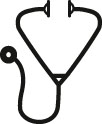Abstract

BACKGROUND: Chimeric antigen receptor T-cell therapy (CAR-T) has revolutionized treatment of relapsed and refractory (R/R) hematologic malignancies. However, relapse and toxicity after CAR-T remain a problem. Addressing these issues requires consideration of multiple immune cell subpopulations, including myeloid cells. Myeloid-derived suppressor cells (MDSC), macrophages, and monocytes contribute to the immunosuppressive tumor microenvironment in solid tumors and lymphomas, and macrophages are known to contribute to cytokine release syndrome (CRS). Investigating changes in myeloid cell populations in the setting of CAR-T in pediatric and adult patients with hematologic malignancies may provide insight into the risk of relapse or severe toxicity. We aimed to determine the changes in myeloid-lineage cell phenotype in patients who receive CD19-directed CAR-T for treatment of R/R B-cell acute lymphoblastic leukemia (B-ALL) or non-Hodgkin lymphoma (NHL), and to determine if there is a relationship between suppressive or inflammatory myeloid cells, toxicity, and response to therapy.
METHODS: We included pediatric patients with R/R B-ALL and adult patients with R/R NHL who received CD-19 CAR-T at our institutions. Blood samples were collected prior to lymphodepleting chemotherapy and again on days 0 (prior to CAR-T infusion), +7, +14, and +90. Mononuclear cells were isolated using density centrifugation. Monocyte, macrophage, and MDSC subpopulations were characterized using multi-color flow cytometry panels. Chart review provided information on primary diagnosis, prior therapy, treatment for CAR-T toxicity, and response to CAR-T.
RESULTS: We enrolled 6 pediatric and 6 adult participants. Seven participants experienced CRS grade 0 or 1; five participants experienced CRS grade 2 or higher (3/5 with B-ALL, 2/5 with NHL), including one participant with concurrent hemophagocytosis lymphohistiocytosis/macrophage activating syndrome. Three participants experienced immune effector cell-associated neurotoxicity (ICANS) of any grade; the remainder experienced no ICANS. Participants with milder CRS and those with no ICANS demonstrated increased populations of CD14+CD11b+CD15-CD33+ monocytic MDSCs (monoMDSC) (mean 8.5% vs 0.06% of live CD3-CD19-HLA/DR- cells), at pre-LDC and D0 timepoints, as well as a trend toward increased iNOS+ monoMDSCs, helping to confirm their immunosuppressive potential. Conversely, participants who went on to receive tocilizumab demonstrated lower monoMDSC levels at pre-LDC, D0, and D+7 timepoints. Two pediatric participants experienced B-cell recovery (at D+52 and D+85), and one adult participant experienced disease relapse after CAR T. Among these participants, there was a trend towards increased monoMDSC populations on D+14 or earlier (pre-LDC monoMDSC mean 13.7% vs 2.7% of live CD3-CD19-HLA/DR- cells). The pediatric participants with B-cell recovery also demonstrated decreases in serum TGFβ levels, with downward trends noted on D+14 or earlier, well before B-cell recovery was observed.
CONCLUSIONS: Analysis of myeloid cell subsets prior to and following CAR-T for R/R B-ALL and NHL reveals important trends. We observed increased monoMDSCs, which are known to have significant immunosuppressive capacity, in participants who experienced less severe toxicity. Absence of monoMDSCs prior to CAR-T may help set the stage for a pro-inflammatory environment. MonoMDSCs were also increased in participants who experienced B-cell recovery or relapse, at least 40 days prior to relapse. While this association has been noted in adult patients with B-cell lymphoma (Jain et al, Blood 2021), the trend has not been fully described in pediatric patients with B-ALL. MonoMDSCs have T-cell suppressive potential and may contribute to loss of CAR-T persistence, thus allowing for B-cell recovery, particularly in the pediatric participants. Along with TGFβ levels, these markers of an immunosuppressive environment may help identify patients at greater risk of severe toxicity or disease relapse. This would allow for tailored toxicity prophylaxis and incorporation of concurrent post-CAR T therapy or earlier transition to consolidative stem cell transplant.
Disclosures
Miller:Cour Pharmaceuticals: Consultancy, Current equity holder in private company, Current holder of stock options in a privately-held company, Membership on an entity's Board of Directors or advisory committees, Research Funding; Takeda Pharmaceuticals: Consultancy. Karmali:AstraZeneca: Other: Advisory Board, Speakers Bureau; Calithera: Consultancy, Membership on an entity's Board of Directors or advisory committees, Other: Advisory Board; Genentech/Roche: Consultancy, Other: Advisory Board; Pharmacyclics: Consultancy, Other: Advisory Board; Morphosys/Incyte: Consultancy, Other: Advisory Board, Speakers Bureau; BeiGene: Consultancy, Other: Advisory Board, Research Funding, Speakers Bureau; Takeda: Research Funding; Kite: Consultancy, Other: Advisory Board, Research Funding, Speakers Bureau; Eusa: Consultancy; BMS/Celgene: Consultancy, Research Funding; Karyopharm: Consultancy. Chaudhury:ViaCord: Membership on an entity's Board of Directors or advisory committees; Alexion Pharmaceuticals: Membership on an entity's Board of Directors or advisory committees; Abbvie: Membership on an entity's Board of Directors or advisory committees.
Author notes
 This icon denotes a clinically relevant abstract
This icon denotes a clinically relevant abstract
Asterisk with author names denotes non-ASH members.


This feature is available to Subscribers Only
Sign In or Create an Account Close Modal